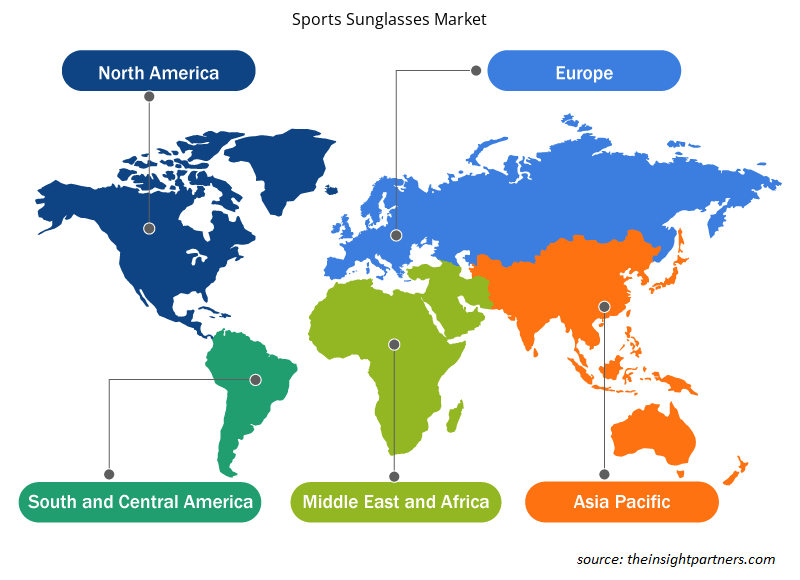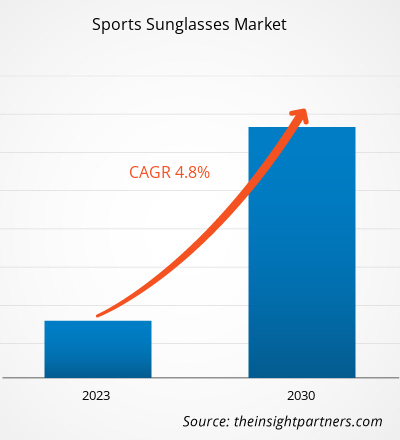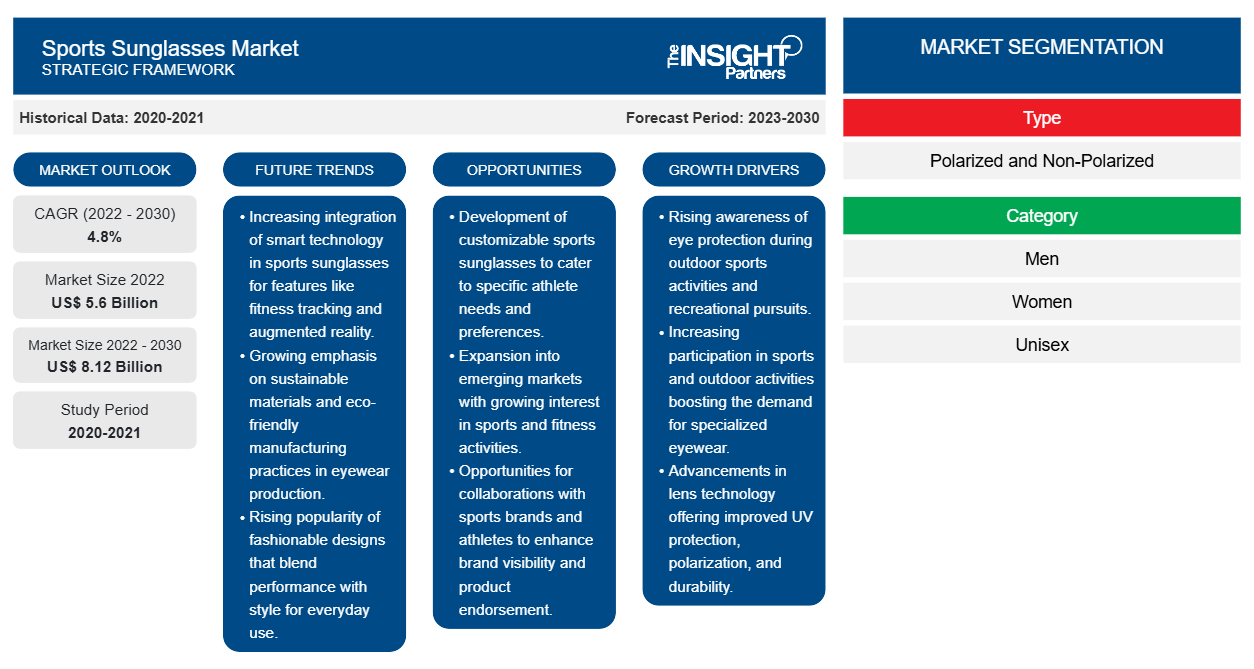[調査レポート] スポーツサングラスの市場規模は、2022年の55億9,708万米ドルから2030年には81億1,506万米ドルに成長すると予測されており、2022年から2030年にかけて市場は4.8%のCAGRを記録すると予想されています。
市場洞察とアナリストの見解:
スポーツサングラスは、屋外スポーツをする際に視認性と快適性を向上させるために使用される保護眼鏡です。強い日光への露出を最小限に抑え、目へのダメージを防ぎます。レンズはプラスチックまたはガラス素材を使用して製造されています。紫外線(UV)ブロッカーと耐衝撃フィルムでコーティングされており、まぶしさを軽減し、コントラストを向上させて、フィールドでの視認性を向上させます。サングラスには、偏光タイプと非偏光タイプがあり、色付きレンズと色なしレンズがあり、日常使いに適しています。スポーツサングラスは、サイクリング、水泳、マウンテンバイク、サイクリング、野球、クリケット、その他の屋外活動などのスポーツ活動を行う際に一般的に使用されます。これらの要因がスポーツサングラス市場を牽引しています。
成長の原動力と課題:
多くの人がさまざまなスポーツやアウトドア活動に従事しています。スポーツ愛好家は、ほこり、風、破片などの潜在的なリスクから目を保護することの重要性を理解しています。そのため、スポーツ活動中に最適な保護を提供し、パフォーマンスを向上させるように設計されたスポーツサングラスを使用しています。スポーツ&フィットネス業界協会(SFIA)によると、米国の人口の76%以上(つまり、2億3,690万人)が2022年に少なくとも1つのアクティビティに参加しており、総参加率は2017年から9.2%上昇し、2021年から1.9%増加しています。また、ユーロスタットによると、2019年には、ヨーロッパの人口の約44%が少なくとも週に1回は何らかの身体活動を行っていました。さらに、多様化するスポーツやアウトドア活動により、特定のニーズを満たすようにカスタマイズされたスポーツサングラスの需要が生まれています。
さらに、より健康的で活動的なライフスタイルへの文化的変化により、スポーツやアウトドア活動を行う人の数が増加しました。この変化は競技選手に限定されず、レクリエーション スポーツ、ランニング、ハイキング、その他のレジャー活動に参加する人も含まれます。スポーツ サングラスはファッション ステートメントとなり、この活動的なライフスタイルの象徴となっています。
特に屋外で紫外線 (UV) に長時間さらされると、白内障、光角膜炎、翼状片など、さまざまな目の状態や疾患を引き起こす可能性があります。これらの状態は不快感、視力障害、場合によっては永久的な目の損傷を引き起こす可能性があります。スポーツやその他の屋外活動に従事する場合、最高のパフォーマンスを発揮するには、クリアで障害のない視力が必要です。紫外線に過度にさらされると、目を細めたり、不快感、視覚の明瞭性の低下を引き起こす可能性があります。UV 保護機能付きのスポーツ サングラスは、アスリートが活動中に最適な視力と集中力を維持し、全体的なパフォーマンスを向上させることを保証します。
要件に合わせてレポートをカスタマイズする
このレポートの一部、国レベルの分析、Excelデータパックなど、あらゆるレポートを無料でカスタマイズできます。また、スタートアップや大学向けのお得なオファーや割引もご利用いただけます。
-
このレポートの主要な市場動向を入手してください。この無料サンプルには、市場動向から見積もりや予測に至るまでのデータ分析が含まれます。
レポートのセグメンテーションと範囲:
「世界のスポーツサングラス市場」は、タイプ、カテゴリ、流通チャネル、および地域に基づいてセグメント化されています。タイプに基づいて、スポーツサングラス市場は偏光と非偏光に分かれています。カテゴリに関しては、市場は男性、女性、ユニセックス、および子供に分割されています。流通チャネルに基づいて、スポーツサングラス市場はスーパーマーケットとハイパーマーケット、専門店、オンライン小売、その他に分割されています。地域別には、市場は北米(米国、カナダ、メキシコ)、ヨーロッパ(ドイツ、フランス、イタリア、英国、ロシア、その他のヨーロッパ)、アジア太平洋(オーストラリア、中国、日本、インド、韓国、その他のアジア太平洋)、中東およびアフリカ(南アフリカ、サウジアラビア、UAE、その他の中東およびアフリカ)、南米および中米(ブラジル、アルゼンチン、その他の南米および中米)に分割されています。
セグメント分析:
タイプに基づいて、スポーツサングラス市場は偏光と非偏光に分かれています。非偏光セグメントは2022年に市場の大きなシェアを占めました。非偏光スポーツサングラスの需要は、パフォーマンス中に目を保護するとともに全体的な健康を確保する必要のあるアスリートやフィットネス愛好家の間で急増しています。レンズ技術の進歩により、より軽量で快適で耐久性のある非偏光スポーツサングラスが導入され、より幅広い視聴者にアピールしています。さらに、ファッション業界がスポーツアクセサリーに影響を与えたことで、アイウェアの選択においてパフォーマンスと美観を求める人々の間でスタイリッシュで機能的な非偏光スポーツサングラスの人気が高まっています。
地域分析:
地理に基づいて、スポーツサングラス市場は、北米、ヨーロッパ、アジア太平洋、南米および中米、中東およびアフリカの5つの主要地域に分割されています。北米は世界のスポーツサングラス市場を支配しました。この地域の市場は、2022年に17億9,100万米ドルと評価されました。ヨーロッパは市場の2番目に大きな貢献者であり、世界市場の約25%を占めています。中東およびアフリカは、予測期間中にスポーツサングラス市場で6.5%のCAGRを記録すると予想されています。北米では、スポーツへの参加の増加と目の保護に関する意識の高まりにより、市場が大幅に成長すると予想されています。スポーツ&フィットネス産業協会(SFIA)によると、2022年には全アメリカ人の76%以上、つまり2億3,690万人が少なくとも1つのスポーツ活動に参加しました。したがって、さまざまなスポーツカテゴリーへの北米人の参加の拡大は、地域全体でスポーツサングラスの需要をさらに高めます。さらに、中東およびアフリカの市場は、スポーツ分野への政府の大規模な投資により、顕著な成長を遂げています。たとえば、サウジアラビアやアラブ首長国連邦を含む湾岸協力会議(GCC)加盟国は、2022年にスポーツ開発に650億米ドル以上を費やし、収益成長の可能性が最も高いとされるサッカーとeスポーツに主に焦点を当てています。個人やフィットネス愛好家の間でスポーツと体力の重要性についての意識が高まっていることから、中東およびアフリカでのスポーツサングラスの需要が高まっています。
業界の発展と将来の機会:
スポーツサングラス市場で活動する主要企業が行っているさまざまな取り組みを以下に示します。
- 2022年12月、英国のアイウェアブランドSunGodは、ロンドンを拠点とするクリテリウムサイクリングチームとコラボレーションし、Vulcanzサングラス「Tekkerz Vulcanz」を発売しました。このモデルには、フォトクロミックレンズ、紫外線記憶ポリマーフレーム、親水性イヤーソックスとノーズパッドが含まれています。
スポーツサングラス市場の地域別分析
予測期間を通じてスポーツサングラス市場に影響を与える地域的な傾向と要因は、Insight Partners のアナリストによって徹底的に説明されています。このセクションでは、北米、ヨーロッパ、アジア太平洋、中東、アフリカ、南米、中米にわたるスポーツサングラス市場のセグメントと地理についても説明します。

- スポーツサングラス市場の地域別データを入手
スポーツサングラス市場レポートの範囲
| レポート属性 | 詳細 |
|---|---|
| 2022年の市場規模 | 56億米ドル |
| 2030年までの市場規模 | 81.2億米ドル |
| 世界のCAGR(2022年 - 2030年) | 4.8% |
| 履歴データ | 2020-2021 |
| 予測期間 | 2023-2030 |
| 対象セグメント |
タイプ別
|
| 対象地域と国 |
北米
|
| 市場リーダーと主要企業プロフィール |
|
スポーツサングラス市場のプレーヤー密度:ビジネスダイナミクスへの影響を理解する
スポーツサングラス市場は、消費者の嗜好の変化、技術の進歩、製品の利点に対する認識の高まりなどの要因により、エンドユーザーの需要が高まり、急速に成長しています。需要が高まるにつれて、企業は提供を拡大し、消費者のニーズを満たすために革新し、新たなトレンドを活用し、市場の成長をさらに促進しています。
市場プレーヤー密度とは、特定の市場または業界内で活動している企業または会社の分布を指します。これは、特定の市場スペースに、その市場規模または総市場価値に対してどれだけの競合相手 (市場プレーヤー) が存在するかを示します。
スポーツサングラス市場で事業を展開している主要企業は次のとおりです。
- 十種競技
- アディダスAG
- ルックスオティカグループ
- リバティスポーツ
- ナイキ
免責事項:上記の企業は、特定の順序でランク付けされていません。

- スポーツサングラス市場のトップキープレーヤーの概要を入手
COVID-19パンデミックの影響:
COVID-19パンデミックは、さまざまな国のほぼすべての産業に悪影響を及ぼしました。北米、ヨーロッパ、アジア太平洋(APAC)、中南米、中東アフリカ(MEA)でのロックダウン、旅行制限、事業停止は、消費財業界を含むいくつかの産業の成長を妨げました。製造ユニットの停止は、世界のサプライチェーン、製造活動、配送スケジュール、必須および非必須の製品の販売を妨げました。さまざまな企業が、2020年に製品の配送の遅れと製品販売の低迷を報告しました。また、危機の初期段階では、製造業者は既存の在庫に大きく依存していました。パンデミックによる経済不況により、消費者は購入の決定においてより慎重かつ選択的になりました。特に発展途上地域では、収入の低下と不確実な収益見通しのため、消費者は非必須の購入を大幅に制限しました。
2021年末までに、多くの国でワクチン接種が完了し、政府はロックダウンや渡航禁止を含む特定の規制の緩和を発表しました。快適性、利便性、パーソナライゼーションへの重点の増加など、パンデミック後のライフスタイルの傾向の変化は、スポーツサングラスの需要に影響を与えました。パンデミック中のオンライン小売の成長も、スポーツサングラスメーカーにチャンスをもたらしました。これに加えて、貿易制限の緩和は輸出入業務を支援し、スポーツサングラス市場の成長にプラスの影響を与えました。
競争環境と主要企業:
Columbia Sportswear Co、EssilorLuxottica SA、Liberty Sport Inc、Under Armour Inc、Nike Inc、Rapha Racing Ltd、Puma SE、Decathlon SE、Adidas AG、およびSafilo Group SpAは、世界のスポーツサングラス市場で活動している著名な企業です。これらの市場プレーヤーは、拡大するための戦略的な開発イニシアチブを採用し、市場の成長をさらに促進しています。
- 過去2年間の分析、基準年、CAGRによる予測(7年間)
- PEST分析とSWOT分析
- 市場規模価値/数量 - 世界、地域、国
- 業界と競争環境
- Excel データセット
最新レポート
お客様の声
購入理由
- 情報に基づいた意思決定
- 市場動向の理解
- 競合分析
- 顧客インサイト
- 市場予測
- リスク軽減
- 戦略計画
- 投資の正当性
- 新興市場の特定
- マーケティング戦略の強化
- 業務効率の向上
- 規制動向への対応























 無料サンプルを入手 - スポーツサングラス市場
無料サンプルを入手 - スポーツサングラス市場